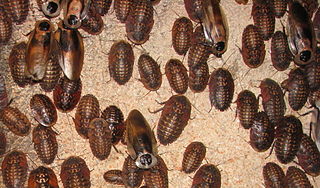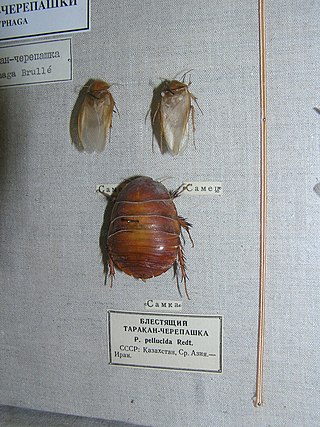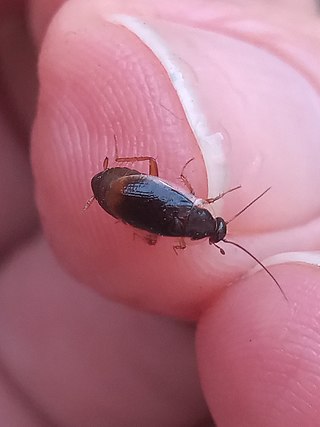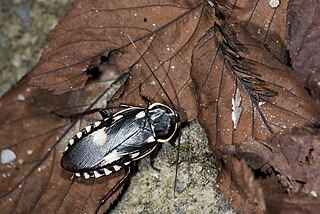
Giant cockroaches, or blaberids, are the second-largest cockroach family by number of species. Mostly distributed in warmer climates worldwide, this family is based on the American genus Blaberus, but much of the diversity is also found in Africa and Asia.

Blattidae is a cockroach family in the order Blattodea containing several of the most common household cockroaches. Notable species include:

Ectobiidae is a family of the order Blattodea (cockroaches). This family contains many of the smaller common household pest cockroaches, among others. They are sometimes called wood cockroaches. A few notable species include:

Corydiidae, previously known as Polyphagidae, is a family of the order Blattodea (cockroaches). Many are known as sand cockroaches. The family is divided into five subfamilies, comprising some 40 genera. One prominent species is the desert cockroach, Arenivaga investigata.

Supella is a genus of cosmopolitan and wild cockroaches, in the family Ectobiidae: originating from Africa and the Arabian Peninsula.

Robert Walter Campbell Shelford, was a British entomologist and museum administrator and naturalist, with a special interest in entomology and insect mimicry; he specialised in cockroaches and also did some significant work on stick insects.

Panchlora is a genus of cockroaches in the subfamily Panchlorinae, erected by Hermann Burmeister in 1838. Species are mostly found in the Americas and Africa. Most species in this genus are green in colour, but some are cream or grey.

Ectobius is a genus of non-cosmopolitan cockroaches once thought native to the Old World and described by Stephens in 1835, belonging to the family Ectobiidae, subfamily Ectobiinae. The discovery of 4 ectobius cockroaches in Colorado dating to 49 million years ago suggests the genus actually originated in North America. This genus has been subject to a number of revisions.

Polyzosteria is a genus of around sixteen species of cockroaches in the Blattidae family native to Australia. Some of these insects are attractively marked, such as Polyzosteria mitchelli. The type species of the genus is the Botany Bay cockroach, Polyzosteria limbata.
Griffiniella is one of several cockroach genera in the subfamily Oxyhaloinae. The genus was described by Heinrich Hugo Karny in 1908, and named by him in honour of the prolific author Dr. Achille Griffini of the Royal Technical Institute of Genoa.

Neostylopyga is a genus of cockroaches described by Robert Walter Campbell Shelford in 1911.

The Pseudophyllodromiinae are a subfamily of cockroaches, in the family Ectobiidae, with a world-wide distribution.

Chorisoneura is a genus of cockroach in the family Ectobiidae. There are at least 90 described species in Chorisoneura.

Pseudomops is a genus of cockroach in the family Ectobiidae. There are more than 40 described species in Pseudomops.

Balta is a genus of cockroaches in the sub family Pseudophyllodromiinae. Found in Asia, Africa, Australia and Oceania. The genus was created in 1893 by Johann Tepper.

Anaplecta is a genus in the family Anaplectidae. There are at least 20 described species in Anaplecta.

Gyna, also called porcelain roaches, are a genus of cockroaches native to Africa.

Corydidarum magnifica, also known as Pseudoglomeris magnifica and the emerald cockroach, is a species of cockroach native to Vietnam and southern China, typically found under leaf litter or on tree bark.

Corydidarum is a genus of Asian cockroaches in the subfamily Perisphaerinae, erected by Carl Brunner von Wattenwyl in 1865. The recorded distribution is central Africa, India, China, SE Asia through to New Guinea.

Paranauphoeta is a genus of South East Asian cockroaches in the family Blaberidae and the monotypic subfamily ParanauphoetinaeRehn, 1951, erected by Carl Brunner von Wattenwyl in 1865. Species records are from India, China, Indochina, Malesia and New Guinea.


















